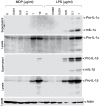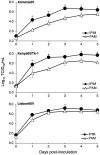Isolation and immortalization of macrophages derived from fetal porcine small intestine and their susceptibility to porcine viral pathogen infections
- PMID: 35923820
- PMCID: PMC9339801
- DOI: 10.3389/fvets.2022.919077
Isolation and immortalization of macrophages derived from fetal porcine small intestine and their susceptibility to porcine viral pathogen infections
Abstract
Macrophages are a heterogeneous population of cells that are present in all vertebrate tissues. They play a key role in the innate immune system, and thus, in vitro cultures of macrophages provide a valuable model for exploring their tissue-specific functions and interactions with pathogens. Porcine macrophage cultures are often used for the identification and characterization of porcine viral pathogens. Recently, we have developed a simple and efficient method for isolating primary macrophages from the kidneys and livers of swine. Here, we applied this protocol to fetal porcine intestinal tissues and demonstrated that porcine intestinal macrophages (PIM) can be isolated from mixed primary cultures of porcine small intestine-derived cells. Since the proliferative capacity of primary PIM is limited, we attempted to immortalize them by transferring the SV40 large T antigen and porcine telomerase reverse transcriptase genes using lentiviral vectors. Consequently, immortalized PIM (IPIM) were successfully generated and confirmed to retain various features of primary PIM. We further revealed that IPIM are susceptible to infection by the African swine fever virus and the porcine reproductive and respiratory syndrome virus and support their replication. These findings suggest that the IPIM cell line is a useful tool for developing in vitro models that mimic the intestinal mucosal microenvironments of swine, and for studying the interactions between porcine pathogens and host immune cells.
Keywords: African swine fever virus; immortalized porcine intestinal macrophages; in vitro model; porcine reproductive and respiratory syndrome virus; porcine small intestine macrophages.
Copyright © 2022 Takenouchi, Masujin, Miyazaki, Suzuki, Takagi, Kokuho and Uenishi.
Figures







Similar articles
-
Establishment and characterization of the immortalized porcine lung-derived mononuclear phagocyte cell line.Front Vet Sci. 2022 Nov 18;9:1058124. doi: 10.3389/fvets.2022.1058124. eCollection 2022. Front Vet Sci. 2022. PMID: 36467652 Free PMC article.
-
Porcine Macrophage Markers and Populations: An Update.Cells. 2023 Aug 19;12(16):2103. doi: 10.3390/cells12162103. Cells. 2023. PMID: 37626913 Free PMC article. Review.
-
Immortalization and Characterization of Porcine Macrophages That Had Been Transduced with Lentiviral Vectors Encoding the SV40 Large T Antigen and Porcine Telomerase Reverse Transcriptase.Front Vet Sci. 2017 Aug 21;4:132. doi: 10.3389/fvets.2017.00132. eCollection 2017. Front Vet Sci. 2017. PMID: 28871285 Free PMC article.
-
Human telomerase reverse transcriptase-immortalized porcine monomyeloid cell lines for the production of porcine reproductive and respiratory syndrome virus.J Virol Methods. 2012 Jan;179(1):26-32. doi: 10.1016/j.jviromet.2011.08.016. Epub 2011 Aug 24. J Virol Methods. 2012. PMID: 21889956
-
Proteomics to study macrophage response to viral infection.J Proteomics. 2018 May 30;180:99-107. doi: 10.1016/j.jprot.2017.06.018. Epub 2017 Jun 21. J Proteomics. 2018. PMID: 28647517 Review.
Cited by
-
Establishment and characterization of the immortalized porcine lung-derived mononuclear phagocyte cell line.Front Vet Sci. 2022 Nov 18;9:1058124. doi: 10.3389/fvets.2022.1058124. eCollection 2022. Front Vet Sci. 2022. PMID: 36467652 Free PMC article.
-
The Potential of Disabled Infectious Single Cycle (DISC) Virus Platforms for Next Generation African Swine Fever Vaccine Development.Transbound Emerg Dis. 2025 Jul 14;2025:8573171. doi: 10.1155/tbed/8573171. eCollection 2025. Transbound Emerg Dis. 2025. PMID: 40692871 Free PMC article. Review.
-
Establishment and characterization of an immortalized red river hog blood-derived macrophage cell line.Front Immunol. 2024 Sep 11;15:1465952. doi: 10.3389/fimmu.2024.1465952. eCollection 2024. Front Immunol. 2024. PMID: 39324137 Free PMC article.
-
Porcine Macrophage Markers and Populations: An Update.Cells. 2023 Aug 19;12(16):2103. doi: 10.3390/cells12162103. Cells. 2023. PMID: 37626913 Free PMC article. Review.
References
LinkOut - more resources
Full Text Sources

